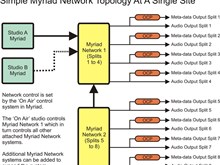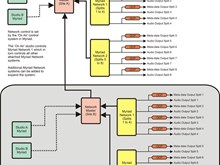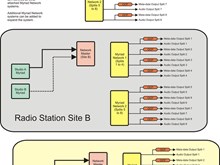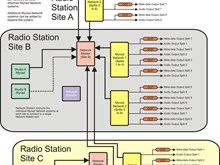Download our free guide to Myriad Network topology.
Networking Options
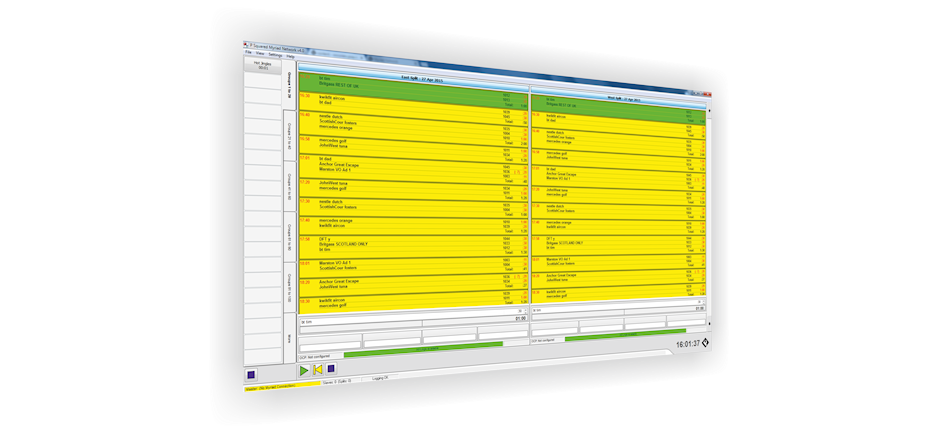
Simple Split Advertising & Branding On A Single Site
Please note that each Myriad Network workstation is capable of providing upto four independent ‘spit’ outputs for adverts and jingles so if you only have four ‘spit outputs’ (FM, DAB, Web & Sky for
example) then you need only have a single Myriad Network machine.
The diagram below shows a simple, single site Myriad Network system with two main broadcast studios (with Myriad playout systems) which connect directly to the primary Myriad Network box. This single workstation is capable of supplying up to four independent outputs for adverts, branding and meta-data (for DAB transmission and websites). If more than four outputs or ‘splits’ is needed then an additional Myriad Network system can be added.
This system connects back to the primary Myriad Network system and is controlled by the primary Myriad Network, not the actual studio Myriad systems. The ‘On Air’ control system built into Myriad is used to select the studio that controls the primary Myriad Network system. This allows you to switch studios and maintain overall network control.
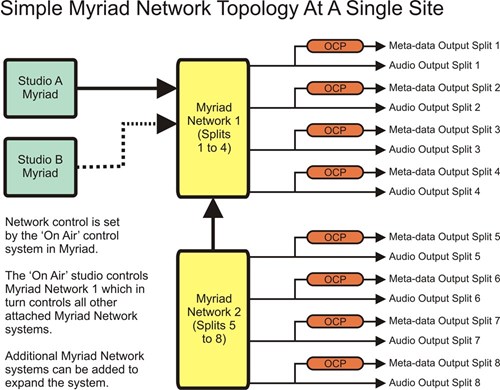
In this model, play information and advert / content duration on the secondary Myriad Network systems is not passed back to the studio Myriad system so only problems occurring on the primary Myriad Network system will be flagged up in Myriad in the studio. So for larger or more complicated networks, we recommend introducing the Network Manager software to further extend the functionality of the system.
Advanced Myriad Network Topology, Scaleable To Multiple Sites
Consider the diagram below.
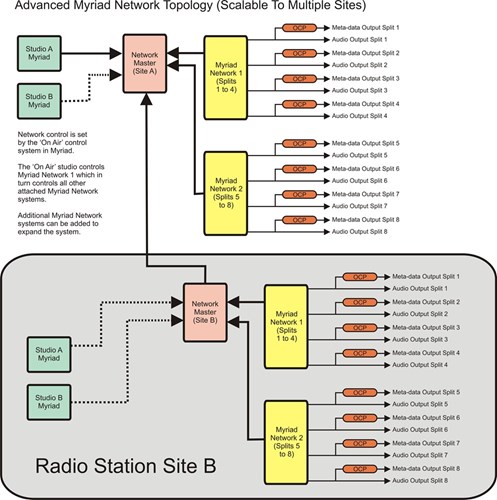
The top section is very similar to out simple model but with the addition of a Network Master application. In this model, each of the Myriad Network systems connects directly to the Network Master application. The ‘On air’ studio Myriad system also connects to the Network Master application. The role of the Network Master application is to relay information and commands from the controlling Myriad system to the connected Myriad Network systems. It also collects information from each of the connected Myriad Network systems and collates the results for the controlling Myriad system which means that Myriad can report if there is an advert of the incorrect length on any of the connected Myriad Network systems and that it will not report an advert break as successfully completed until all of the connected Myriad Network systems have reported back to the Network Master that they have finished playing the adverts.
In this way, the Network Master acts as a mediator between the studio Myriad system and the Myriad Network systems, relaying commands from the studio and compiling information to be fed back into the studio but without the need for Myriad to connect directly to local or remote Myriad Network systems.
Where is starts to get more interesting is the fact that you can connect Network Master systems effectively ‘daisy chaining’ Myriad Network systems at different sites.
If you look at the bottom section of the diagram above you will see that there is a secondary site (called Site B) that has an identical setup to the initial site but with the option to have the Network Master in ‘Site B’ controlled by either the local studios or directly from the Network Master in ‘Site A’. This allows for ‘Site B’ to either have local programming that they control themselves (via Myriad in their studios) or network controlled programs controlled via ‘Site A’ but with local adverts etc.
As we have already touched on, one of the roles of the Network Manager application is to collate information about avert break / content length and play status and relay that to the controlling studio via Myriad. In the scenario where a secondary Network Master is connected to a primary Network Master, it passes it’s collated information back ‘up the line’ to the primary Network Master meaning that the information presented in the controlling studio is collated from the whole network. So an advert break will only be displayed as finished in the studio once all the Myriad Network splits have finished across both sites! There is, of course some safety checks in place to ensure that a faulty Myriad Network system at a remote site will not halt then entire network output.
The above scenario is very effective if you have a main site which provides ‘network output’ and secondary sites that can switch between local provision and network programming (but always with local adverts and branding).
But what if that was not the case, what about if each site needed to be able to provide ‘network output’ but only at specific times?
Advanced Configuration Network Topology Using Myriad Network Director
In the diagram below, you can see that we now have three radio station sites (let’s call them A, B and C) but we no longer have any control lines connecting the Myriad Network systems to the Network Master systems, nor do we have any interconnects between the Network Master systems so effectively we start with a blank slate.
In this type of scenario, we introduce a forth software application called Network Director. The job of Network Director is to create the control lines between the Myriad Network systems and the Network Masters. The key thing to remember is that the Network Director is used to configure the Myriad Network boxes to talk to a Network Master. This is done as a single instruction and once successfully completed, the Network Director is removed from the equation until next time you need to reconfigure your network so no control passes through the Network Director software and it can be closed down at any time without affecting your overall system.
It would be common to run a copy of Network Director at each station to allow any site (with appropriate security policies in place at the station) to reconfigure the radio network as appropriate.
Now let’s imagine that we have a copy of Network Director at each station and that for the next two hours, we need all of the main audio for the network to come from site B but obviously with local
adverts and jingles at each site.
To do this, any of the stations that have Network Director can load the software and select the site that the main audio will come from as well as which Myriad Network (i.e. which splits) should be
included. Once committed, the Network Director contacts each Myriad Network system at each site and instructs them to connect directly to the Network Master at the site that is originating the main
broadcast. Once these instructions have been relayed, Network Director is removed from the equation.
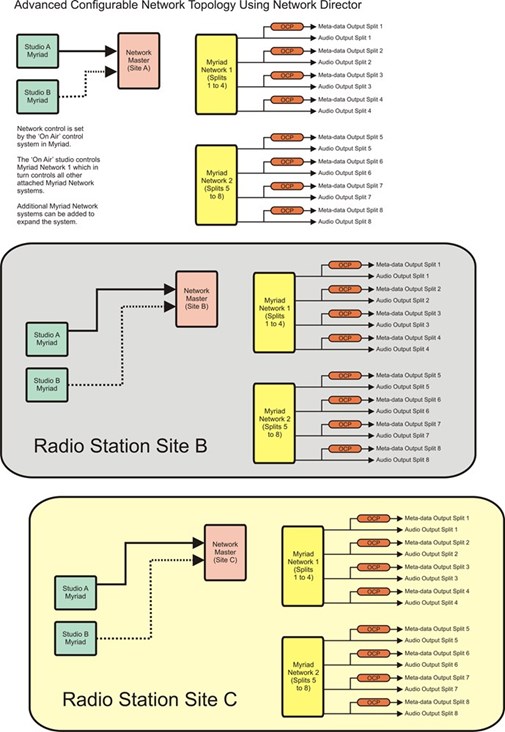
The diagram bellow shows the topology after Network Director has instructed all of the Myriad Networks to connect to the Network Master at site B.
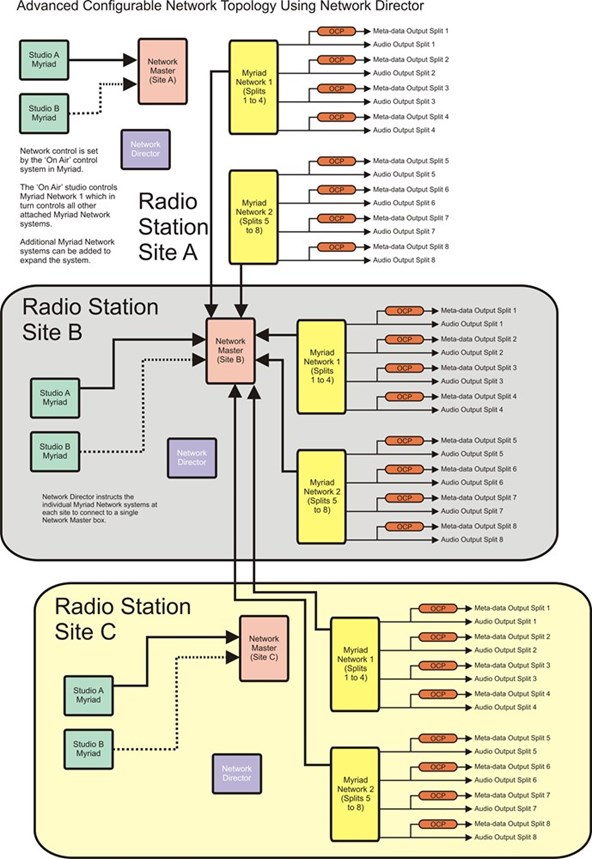
As you can see, this it different to the second scenario we looked at in that the Myriad Networks are connecting directly to the primary Network Master ignoring the local Network Master altogether.
This is necessary to allow the remote configuration of the network via Network Director.
In all cases, the individual studio that is driving the network is selected using Myriad’s standard ‘On Air Control’ feature.
Bespoke Solutions
By it's very nature, Myriad Network offers a wealth of potential network options for any radio group wishing to leverage the benefits of centralised resources whilst maintaining localised content and revenue. By mixing local and national advertising revenues you can maximise station income, reduce costs (by centralising playout) and maintain the local 'feel' to the station with location specific branding and information.
We have a wealth of experience in designing and deploying network radio solutions and will be happy to provide a bespoke solution to suit your group needs and infrastructure.
Myriad Network Topology Diagrams
Click on the thumbnails to view the different Myriad Network topology options.
For a free, no obligation consultation and quote, please contact our expert team today.
